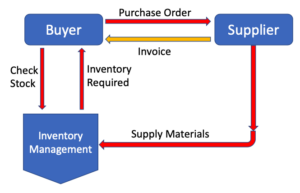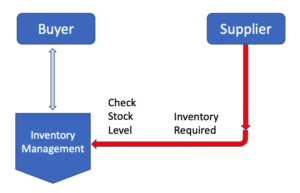Vendor Managed Inventory, or VMI agreements, have been a trend in manufacturing for some time. Under such an agreement, a supplier physically manages the inventory of goods at the customers facility. The supplier makes certain that stock is replenished properly and that the min/max levels are held at the right quantities. It’s a mutually beneficial relationship where both sides can smoothly and accurately control the flow of goods. The goal of an effective VMI program is to reduce the uncertainty that occurs when a supplier is blind to their customers inventory status.
Companies like Anixter and TTI have had VMI programs with harness manufacturers for consumables like wire and components for many years. More recently, however, harness manufacturers are using this successful model with their customers where assembly quantities and demand schedules make VMI programs a plausible solution.
In this article, we will define VMI and discus various ways a vendor can design them. We then turn to the benefits and pitfalls of these programs and take a look at useful implementation tactics. Finally, we turn to a recent discussion with Colleen Weber, Business Manager, and Shaun McGuire, General Manager, at Excel Connection, a harness and cable assembly supplier in Milwaukee WI. We discussed how they use VMI programs on both sides of the equation, managing the flow of inventory from their vendors, through to their customers. At the end, you will find some useful links for additional reading, along with links to companies providing some tools you can use to make VMI programs run effectively.
In a typical VMI program, the vendor is on site at the customers location at some point, counting and replenishing stock. In many cases, a vendor may have access to a customer’s MRP/ERP software to see what the actual inventory levels are. In such cases, the customer would need to partition off only that data useful to the vendor.
Some companies choose to use a barcode system where the customer scans the product and gives the vendor daily, weekly or monthly usage numbers. Many companies use a low-tech option where stock on shelves is photographed at the end of a period for an inventory count. It can also be as simple as an Excel spreadsheet provided by the customer to show stock levels.
BENEFITS
It costs money to carry inventory, but it also costs money to lose sales due to lack of inventory. A well-tuned VMI program creates a balance that eliminates the lost sales cost of inventory for the seller, while reducing carrying costs for the buyer.
VMI programs can also protect against a customer who can’t plan. A well communicated and strictly monitored VMI can actually help a customer plan better and reduce the hassles with expediting materials for last minute orders. It helps smooth out the demand curves for both suppliers and customers.
PITFALLS
Almost all pitfalls to VMI programs are the result of poor communication or an unclear agreement between the vendor and customer. Unrealistic expectations, ambiguous demand schedules and unmonitored min/max levels are recipes for disaster. Suppliers need a great deal of visibility into sales and inventory levels at the customer. Further, even though the customer is typically responsible for WIP and finished goods, this should be clearly spelled out in the agreement.
VMI AT EXCEL
Coleen began our discussion describing how Excel uses VMI programs from their suppliers. A separate cage houses the materials owned by the supplier. Goods have a bar code or part number ticket on the shelf. As goods are pulled, the code or part number, along with the quantity, are entered on a purchase order. The vendor picks up those purchase orders once, or sometimes twice a week, and replaces goods in the carousel. Excel has another VMI vendor whose products they use on a regular basis. They have set up a reorder report with appropriate min/max levels. Every week, the vendor looks at it and ships materials based on stock levels. Coleen monitors the min/max levels to verify they are tied into forecasted customer demand.
Shaun pivoted to a description of the VMI initiatives with Excel has instituted with some customers. “There’s multiple ways of doing it,” he advised. “We have customers where we drop off material and they issue purchase orders. We have other customers where we go in and check to see what they have. Our people replenish the stock, they cut us a PO and we deliver the next day.” He mentioned they have other customers that have blanket orders. They notify Excel by email when they hit a certain stock level, and Excel ships the next day.
By using VMI programs on both the supplier and customer ends, Excel is able to keenly manage the flow of goods through their facility. “Think of it as continuous buckets of goods,” Shaun described. “One bucket is coming from our suppliers, one bucket is in our cage, one bucket is in WIP, another one is in finished goods, and one bucket is at our customer’s site. So the faster they use that bucket of finished goods at the customer, the faster we need to dump that load of raw materials.”
When queried about which customers or products they seek to place under a VMI program, Shaun indicated it has less to do with the dollar amount and much more to do with the product demand. “A lot of manufacturers look at the golden carrot and they want a high dollar amount to justify a VMI,” he explained. “Sure, we look at dollar amount, but it’s really continual usage; even if it’s low-volume, we can still do a VMI if the demand is steady.” At the end of the line, the customers are generally responsible for WIP and finished goods.
The overwhelming theme of the conversation with Shaun and Coleen is that the success of a VMI program rests on the completeness of agreements set forth between supplier and vendor, coupled with the constant communication between both parties. The key seems to be managing expectations. “There’s no one size fits all because it depends on how each customer buys into it, and what part of the responsibility they will take,” Shaun advised.
EMERGING TREND – JMI
An emerging trend in supply chain management is Jointly Managed Inventory (JMI). JMI is a broader and more detailed form of VMI with more of a partnership agreement between supplier and customer. The goals are very similar, but the width and breadth of shared information is more intense. Its really just a more finely tuned VMI where the vendor has access to the suppliers sales data downstream. The increased visibility allows the supplier to gain real-time insight into sales data so they can better improve the replenishment function while improving inventory planning with their own suppliers. Think of it as adding extra buckets in the chain in Sean’s example from above. It may or may not have applications in our industry, but it’s certainly worth consideration.
This article can be found in Wiring Harness News



